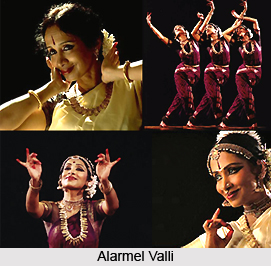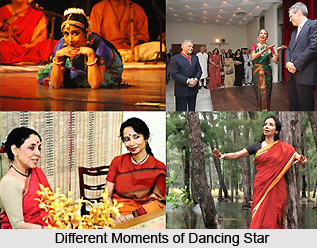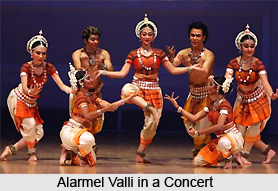 "Valli enchants the initiated and the uninitiated alike - What is it that sets her apart? It is her ability to infuse beauty into whatever she creates, to transcend mere grammar and technique, to invest it with poetry and joy, giving dance an added dimension as it were. Her dance becomes `abundance`, `Sampurna`-an uplifting experience" ---- asserts The Economic Times. Internationally acclaimed Alarmel Valli is a creative artist whose work reveals the infinite spaces within the traditional form. Alarmel Valli bases her dance on the principle that Bharatanatyam is a superbly evocative language, where the dancer who has mastered and internalized the idiom can write her personal dance poetry. In her choreography Valli explores the complex layers of meaning in poems and lyrics. Drawing on her knowledge of music and the rich subtlety vocabulary of classical Indian dance, she has given her work a visual and melodic dimension. For bringing depth, passion and spontaneity into her work, people have applauded her.
"Valli enchants the initiated and the uninitiated alike - What is it that sets her apart? It is her ability to infuse beauty into whatever she creates, to transcend mere grammar and technique, to invest it with poetry and joy, giving dance an added dimension as it were. Her dance becomes `abundance`, `Sampurna`-an uplifting experience" ---- asserts The Economic Times. Internationally acclaimed Alarmel Valli is a creative artist whose work reveals the infinite spaces within the traditional form. Alarmel Valli bases her dance on the principle that Bharatanatyam is a superbly evocative language, where the dancer who has mastered and internalized the idiom can write her personal dance poetry. In her choreography Valli explores the complex layers of meaning in poems and lyrics. Drawing on her knowledge of music and the rich subtlety vocabulary of classical Indian dance, she has given her work a visual and melodic dimension. For bringing depth, passion and spontaneity into her work, people have applauded her.
Alarmel Valli developed an interest in dance right from her childhood. She was born in the year 1957. She settled down abroad after married to Bhaskar Ghosh, former I&B secretary and former director general of Doordarshan. At the age of 16, she was invited to perform at the international Dance festival of the Sarah Bernardt Theatre De La Ville in Paris. From then she received acclaims for her performance all over the world.
Pandanainallur Sri Chokkalingam Pillai and his son Sri Subbaraya Pillai were the great masters who trained Alarmel Valli. To evolve her own distinctive style she has extended the limitations of her dance tradition with her enriched dance vocabulary. Her dance form has been described as "uniquely individualistic…an effortless synchronization of apparent contradictions - linearity and lyricism, symmetry and sinuosity, precision and poetry". Within the framework of classical Indian dance, Alarmel Valli`s work is contemporary in its interpretation and scope to communicate. Her work has been glorified for creating an international awareness of Bharatanatyam, as a dynamic, continuously evolving, classical dance form. A foreign critic writes - "Valli`s dance, is movement as pure joy… An Alarmel Valli or Suzanne Farrel can literally embody, infinite subtleties of the emotions, intricacies of design, glimpses of the Divine. They can, momentarily at least, wrench order out of chaos".
 By her study of Odissi Under renowned Guru Kelucharan Mohapatra and Guru Ramani Ranjan Jena Alarmel Valli`s perception of dance has also been enriched. Valli has studied ` Padams` and ` Javalis` for many years under the eminent musician Smt.T.Muktha, of the renowned Veena Dhanammal style of music. It has helped her to explore the ideal of dance as visual music. Her work expresses a slick distinction, between the literal translation of the lyric into body language and it matured and it resulted into transmutation of music into movement.
By her study of Odissi Under renowned Guru Kelucharan Mohapatra and Guru Ramani Ranjan Jena Alarmel Valli`s perception of dance has also been enriched. Valli has studied ` Padams` and ` Javalis` for many years under the eminent musician Smt.T.Muktha, of the renowned Veena Dhanammal style of music. It has helped her to explore the ideal of dance as visual music. Her work expresses a slick distinction, between the literal translation of the lyric into body language and it matured and it resulted into transmutation of music into movement.
Valli has done research for around 12 years on classical Tamil anthologies of Sangam poetry (2000 years old) and she has worked to give the richness of the poems a visual and melodic dimension. As the late A.K Ramanujan says of these classical poetry "not to know them, is not to know a unique and major poetic achievement of Indian civilization."
Recipient of Numerous awards Alarmel Valli was honored with the title of `Kalaimamani` by Government of Tamil Nadu in 1979, the title of the `State Artist` of Tamil Nadu in1981 and in1984, Nritya Choodamani Award in1985, "Padma Shri" Award in1991, Grande Medaille de la Ville de Paris Award in1997, Sangeet Natak Akademy (the apex body for Music, Dance and Drama in India) Award in 2001. Alarmel Valli was the youngest dancer to be conferred the President`s award of "Padma Shri". She was awarded one of India`s highest civilian awards the `Padma Bhushan` in 2004.
Alarmel Valli founded `Dipashikha`, a Center for Performing Arts, in the year 1984. The center was set up with the aim of imparting training to promising new artists. Valli shares her thoughts on Bharatanatyam and on tradition as a dynamic process of renewal and change through lecture demonstrations, master classes, workshops and seminars in India and abroad. A few of the forums in which she has worked, include Spic Macay in India, the Societe Italiana del Flauto Dolce, The Philharmonic society in Rome, the International Sommertanzwochen in Vienna and Universities across the US.
Producer Michael Macintyre made a film on Alarmel Valli for the Omnibus series, on BBC 2. Noted Indian producers like the late G. Aravindan and Prakash Jha have also featured Alarmel Valli in dance documentaries. The BBC (in The Spirit of Asia Series), the Nederlands Broadcasting Company, Arte (France) and Japanese National Television have also featured her. The Films Division of India commissioned a film `Pravahi` on her for the Indian National Archives directed by eminent filmmaker Arun Khopkar, with cinematography by Madhu Ambat.
She has won laurels several times in the major festivals in India and in almost all the cultural capitals of the world. Her major performance in India includes
| Akshaya Festival (Delhi) | Dover Lane Music Festival (Calcutta) | Kala Academy`s Sangeeth Samroh (Goa) | Mylapore Fine Arts Festivals (Madras) | Sawai Gandharva Festival (Pune) |
| Bhagyachandra Cultural Festival (Manipur) | Elephanta Festival (Bombay) | Kalakshetra Festival (Madras) | Naradha Gana Sabha Festivals (Madras) | Shanmugananda Festival (Bombay) |
| Bharat Kalachar Festivals (Madras) | Ellora Festival (Bombay) | Kalidas Festival (Bhopal) | Nishagandhi Festivals (Kerala) | Soorya Dance Festivals (Kerala) |
| Bharatotsav Festival (Kerala) | Festival of the Sangeet Natak Academy (Delhi) | Khajuraho Festival | Nrityagram`s Cultural Festival (Bangalore) | Tamil Isai Sangam (Madras) |
| Chembur Fine Arts festival (Bombay) | ICICI`s Siddharth Mehta Festival (Bombay) | Kinkini Nrithyotsav Festival (Bangalore) | Pracheen Kala Kendra`s Festival (Chandigarh) | Tansen - Tyagaraj Samroh (Lucknow) |
| Cultural Festival organized by the Tata Theatre (Bombay) | Indian Fine Arts Society Festivals (Madras) | Krishna Gana Sabha Dance Festivals (Madras) | Sahitya Kala Parishad Festival (Delhi) | The NCPA (National Center for Performing Arts, Bombay) |
| Delhi Tamil Sangam Festival | Indus (Bombay) | Music Academy Festivals (Madras) | Sangeet Natak Academy Festival (New Delhi) |
 On her own words "A dancer`s life is a continuous process of artistic evolution - of reflection, of dynamic growth and change. We choreograph new dances; we renew and rework old ones. Even during performances we are continuously improvising. When I first studied dance, I learnt the rules. Over the years, with constant practice, I was able to internalize them. At this stage, I found I was making some rules of my own. But the final step is when you identify completely with the dance. To borrow the words of YB.Yeats- `O Body swayed to music, O Brightening glance! How can we know the Dancer from the Dance?` ". Alarmel Valli is a foremost exponent of the Pandanallur tradition in BharataNatyam.Alarmel Valli`s owns distinct style, which emerged as a result of her practice as well as research, has enriched the domain of Bharatanatyam.
On her own words "A dancer`s life is a continuous process of artistic evolution - of reflection, of dynamic growth and change. We choreograph new dances; we renew and rework old ones. Even during performances we are continuously improvising. When I first studied dance, I learnt the rules. Over the years, with constant practice, I was able to internalize them. At this stage, I found I was making some rules of my own. But the final step is when you identify completely with the dance. To borrow the words of YB.Yeats- `O Body swayed to music, O Brightening glance! How can we know the Dancer from the Dance?` ". Alarmel Valli is a foremost exponent of the Pandanallur tradition in BharataNatyam.Alarmel Valli`s owns distinct style, which emerged as a result of her practice as well as research, has enriched the domain of Bharatanatyam.



















